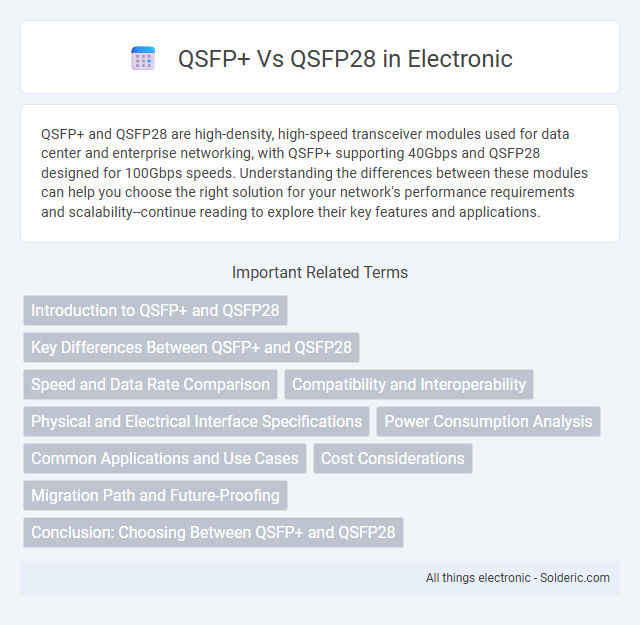QSFP+ and QSFP28 are high-density, high-speed transceiver modules used for data center and enterprise networking, with QSFP+ supporting 40Gbps and QSFP28 designed for 100Gbps speeds. Understanding the differences between these modules can help you choose the right solution for your network's performance requirements and scalability--continue reading to explore their key features and applications.
Comparison Table
| Specification | QSFP+ | QSFP28 |
|---|---|---|
| Data Rate | 40 Gbps | 100 Gbps |
| Channels | 4 x 10 Gbps | 4 x 25 Gbps |
| Form Factor | Quad Small Form-factor Pluggable | Quad Small Form-factor Pluggable 28 |
| Compatibility | 40G Ethernet, InfiniBand QDR | 100G Ethernet, InfiniBand EDR |
| Power Consumption | Typically < 3.5 W | Typically < 4.5 W |
| Use Case | Data center 40G uplinks & switches | Data center 100G uplinks & switches |
| Backward Compatibility | Supports 10G breakout cables | Supports 40G breakout cables |
| Lane Speed | 10 Gbps per lane | 25 Gbps per lane |
Introduction to QSFP+ and QSFP28
QSFP+ (Quad Small Form-factor Pluggable Plus) supports 40 Gbps data rates and is widely used for high-speed data center interconnects and networking applications. QSFP28 enhances this capability by providing 100 Gbps per lane, achieving up to 400 Gbps total bandwidth, suitable for next-generation data centers and high-performance computing environments. Both form factors share similar physical dimensions but differ in speed, with QSFP28 offering significantly higher data throughput and improved signal integrity.
Key Differences Between QSFP+ and QSFP28
QSFP+ and QSFP28 are high-speed transceiver modules designed for data centers and enterprise networks, with QSFP+ supporting 40Gbps and QSFP28 enabling 100Gbps data rates. The main difference lies in their signaling rates, where QSFP+ operates at 10Gbps per lane across four lanes, while QSFP28 increases this to 25Gbps per lane, enhancing bandwidth and performance. Understanding these distinctions helps you choose the appropriate module for upgrading network infrastructure to meet higher data throughput demands.
Speed and Data Rate Comparison
QSFP+ supports speeds up to 40 Gbps, making it suitable for high-performance data center applications, while QSFP28 doubles the data rate capacity, offering speeds up to 100 Gbps. QSFP28's enhanced data transfer capabilities enable more efficient handling of large-scale network traffic and higher bandwidth demands. Choosing between QSFP+ and QSFP28 depends on your requirement for speed, with QSFP28 being the optimal choice for next-generation high-speed connectivity.
Compatibility and Interoperability
QSFP+ and QSFP28 modules differ primarily in data rates, with QSFP+ supporting up to 40Gbps and QSFP28 designed for 100Gbps, impacting their compatibility within network environments. Interoperability between these transceivers requires careful consideration of the host device's specifications and firmware, as QSFP28 ports may support QSFP+ modules in a backward-compatible mode but not vice versa. Proper selection ensures seamless integration and maximizes network performance without signal degradation or protocol mismatches.
Physical and Electrical Interface Specifications
QSFP+ and QSFP28 share a similar physical form factor with a compact 38.35mm x 13.5mm x 8.5mm size, facilitating easy integration into high-density network equipment. QSFP+ supports 4x10 Gbps lanes for a total of 40 Gbps, while QSFP28 increases lane speed to 28 Gbps, enabling a total bandwidth of 100 Gbps within the same electrical interface framework. The electrical interface of QSFP28 incorporates improved signal integrity and enhanced power management to accommodate higher data rates and maintain compatibility with existing QSFP+ modules.
Power Consumption Analysis
QSFP28 modules typically consume more power than QSFP+ due to higher data rates of up to 100 Gbps compared to QSFP+'s 40 Gbps, influencing thermal management requirements in data centers. QSFP+ power consumption ranges generally around 1.5 to 3.5 watts, while QSFP28 modules often range from 3.5 to 5 watts depending on the specific manufacturer and module design. Efficient power consumption in QSFP28 is critical for high-density deployments to minimize overall energy costs and maintain optimal system reliability.
Common Applications and Use Cases
QSFP+ modules support 40Gbps data rates primarily used in data center aggregation, high-performance computing, and enterprise network uplinks. QSFP28, designed for 100Gbps transmission, serves high-bandwidth applications like hyperscale data centers, cloud computing infrastructure, and telecommunications backbone networks. Both standards facilitate high-density, low-latency connections but QSFP28 enables advanced 100 Gigabit Ethernet (100GbE) deployments critical for next-generation networking demands.
Cost Considerations
QSFP+ modules generally offer lower initial costs compared to QSFP28, making them a more budget-friendly option for 40Gbps networking. QSFP28 supports 100Gbps speeds with higher power consumption and greater complexity, often resulting in higher price points for both transceivers and compatible hardware. Organizations must weigh the cost difference against future scalability and performance needs when selecting between QSFP+ and QSFP28 technologies.
Migration Path and Future-Proofing
QSFP28 provides a clear migration path from QSFP+ by supporting higher data rates up to 100Gbps, enabling seamless upgrades in existing network infrastructures without complete overhauls. The backward compatibility of QSFP28 with QSFP+ modules ensures cost-effective scalability and investment protection. Future-proofing is enhanced as QSFP28 aligns with emerging 400Gbps standards through aggregation, making it suitable for evolving data center and telecom demands.
Conclusion: Choosing Between QSFP+ and QSFP28
QSFP+ supports 40Gbps data rates, ideal for legacy systems or cost-sensitive projects, while QSFP28 offers up to 100Gbps, meeting higher bandwidth and future-proofing requirements. Your decision should balance current network demands with scalability, as QSFP28 enables advanced data center and enterprise applications with improved performance and efficiency. Selecting the appropriate module ensures optimized infrastructure investment and aligns with your long-term connectivity goals.
QSFP+ vs QSFP28 Infographic

 solderic.com
solderic.com